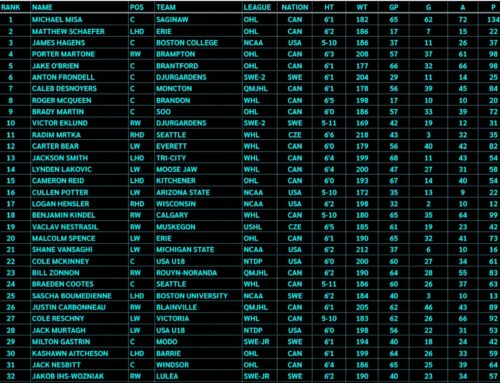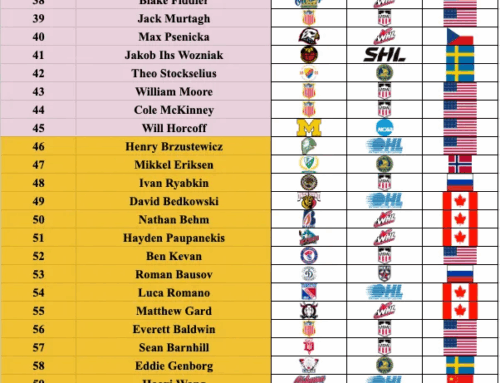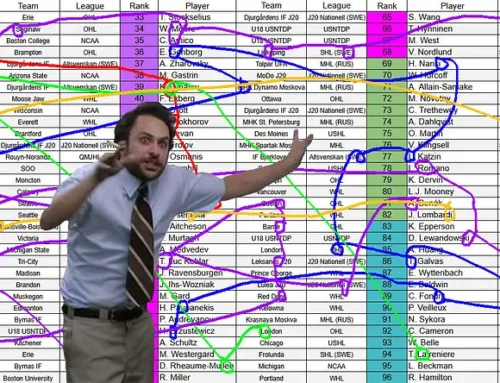Draft Class Deep Dive: RW Dawson Mercer
Tony Ferrari
2020-09-07
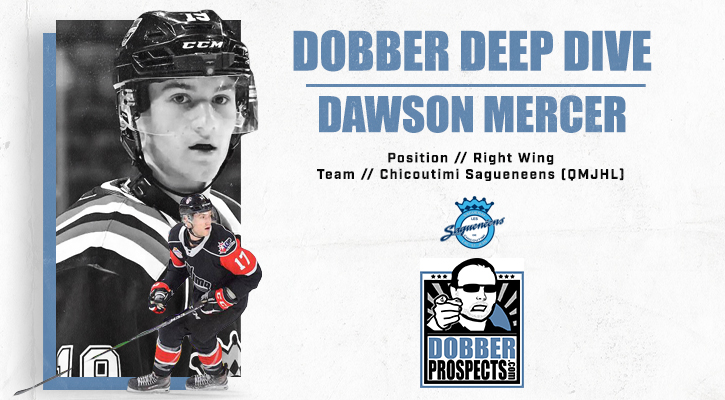
The ability to play all three forward positions. Safe middle-six projectability. Dual-threat offensive talent. Competitive defensive player. These traits are all reasons that lead many to believe that Dawson Mercer could be one of the safest picks outside of the top-ten. Every step that he takes and every level he plays at, Mercer is able to make his mark up and down the lineup. Starting the season on a torrid pace with the Drummondville Voltigeurs prior to being a surprise addition to the Canadian World Junior team. Traded to the Chicoutimi Saguenéens while with the Canadian junior squad, Mercer’s production dipped with his new squad but his strong play continued.
The Newfoundland native could be a coach’s dream. Mercer had a busy year between the two different teams in the QMJHL, Team Canada, and playing in various prospect games throughout the year but he continued to do his job and contribute, even when he doesn’t find the scoreboard. The small details of his game are good and he is not a player you have to push for effort. His high-level hockey sense and the ability to exploit defenses because of it are key to Mercer establishing himself as a top-20 prospect for the 2020 NHL Draft.

Dawson Mercer bio information courtesy of Elite Prospects
As we break down Mercer’s game, an appreciation for the versatility and projectability will begin to rise. He looked much faster and stronger with Drummondville in the first half of the year. His production pre- and post-World Juniors was markedly different. He went from 42 points in 26 games with the Voltigeurs to 18 points in 16 games with Chicoutimi. It is likely a combination of his ice-time going from 22:29 TOI/GP in Drummondville to 20:39 TOI/GP in Chicoutimi as well as not being as comfortable with his new teammates with the Saguenéens. Having as a busy a year as Mercer along with the trade, it’s not a complete shock to see the Canadian World Junior gold medalist slow down as the year wore on.
Finishing Power
One of the best traits in Mercer’s game is the ability to finish around the net and clean up the garbage from a pile. As we can see from his shot chart below, the vast majority of his goals and shots come from between and below the faceoff dots. This is promising for his NHL translatability because it leads evaluators to believe that with his ability and willingness to get to high-danger areas, he should be able to continue scoring goals and playing the finisher role on his line at the next level.
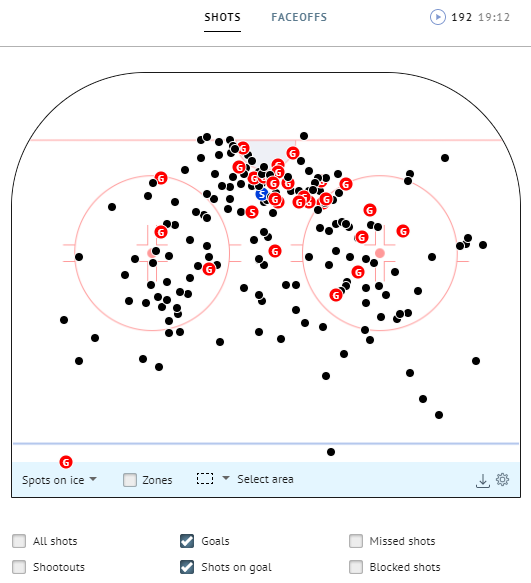
Dawson Mercer shot chart courtesy of InStat Hockey.
The key to Mercer’s finishing ability is his timing. The young Canadian has a knack for finding open ice around the net. The ability to seemingly move undetected around the offensive with ease is impressive. He is a quick thinker, using that IQ to identify when his opponents are frozen by puck movement and take advantage of it, even if he just gives himself that extra split second on time and space. The first clip in our examination of Mercer’s game shows this trait perfectly. Coming from the left-wing position along the boards in an offensive zone faceoff, the puck goes back to the left point. This freezes the defenders for just a half-second, allowing Mercer to cross their faces to the inside, a cardinal sin when playing effective defense. We’re talking about Mercer’s finishing ability here so you can guess what happens next.
Mercer is a goal scorer who doesn’t have a hard and heavy shot that many modern-day goal scorers possess. He utilizes a quick release and excellent accuracy to remain an effective scorer. Whether he is on a two-on-one or sneaking into the play, the puck pops off his stick quickly. His skating is above average which allows him to pull away and create space. Driving the slot on the rush allows him to ensure that he is in a great position to utilize his tools.
In the play below, we see Mercer make a good defensive play to get the puck out of the defensive zone and then join the rush. He banks the puck around the attacker along the boards, corrals the puck, and hands it off to his linemate, bolting up ice. Mercer gets on his horse and drives the slot, attacking the net with a purpose. He has a bit of a long stride, maintaining space between himself and the defenders.
His accurate shot and penchant for taking the space that the defensive unit gives him help make him a dangerous threat on the powerplay as well. He is patient with the puck, rarely rushing decisions. He has the presence of mind to wait out his opposition. While there is a feeling that Mercer may not be the player on the half-wall when he gets to the NHL, his brain allows him to play in just about any position with the man advantage, likely settling into the bumper slot where he can use his tools and get shots on net from a close proximity as well as attacking the net to clean up rebounds, as he does so well.
There is an element to simplicity to the way Mercer finds ways to produce. That’s certainly not to say that he is unable to bring some razzle and dazzle to his game because, as we will get into shortly, there is some ‘wow’ to his game when it comes with stick-handing and effort. Mercer is, at worst, a high-level finisher around the net. Adding in the skills we will get into, Mercer brings a bit more than his somewhat simplistic, yet effective, goalscoring to his game.
Puck on a String
When beginning this film study, my opinion of Mercer fit what many in the public sphere think. Good, stable, safe forward. Limited flash and pop to his game but he gets the job done. As one video turned into the next, there was a growing theme. This kid has hands. He will need to refine it a bit as there are times, as seen below, where his stickhandling looks good until the puck scurries off his stick after a number of moves. It’s an impressive trait to be able to consistently take the puck back, but keeping it is key.
What leads you to believe that he may be able to transfer his puck skills to the next level is that he uses it to get himself out of trouble, not just to show that he has it. Doing things with a purpose is a recurring theme in Mercer’s game. Far too many players use their stickhandling as their only means for eluding the opposition, far too few use it to accomplish a task. That’s what separates Mercer from some of the other dazzling danglers in the draft class. In the next video in our study, we see Mercer battling in the corner before emerging with the puck. He then has the skill and sense to evade the defender, cross through the crease, and put his own rebound in the net.
Mercer isn’t the most involved player in transition, we’ll get to that, but he is more than capable of moving the puck up ice and his smooth puck skills are certainly a factor that can be attributed to it. A player has to be able to sync up their hands and feet in transition. This isn’t a trait that many junior-aged players have as they generally have one or the other a bit more advanced therefore making it difficult to fully utilize their skillset. In the video below, we see how effective Mercer can be as he is able to stay strong on his edges, agile on his feet, and swift with his hands.
The Great Canadian Try-Hard

Table A: Stats and data compiled from InStat Hockey. (TO Battle% is how many takeaways vs. how many giveaways the player has. Challenge% is how many one-on-one battles the player wins. Color grading: Blue = Good, Red = Bad)
One of the themes that persist in Mercer’s game is effort. When we look back at the table above, we can see that he lags behind his draft range comparables with the second-lowest challenge percentage of the group. 45.8% is a considerably low number, with most forwards averaging closer to 48%, which is why pairing the analytics and eye-test is integral when breaking down a player’s game. Why is the player losing his battles? Is there an effort issue or a strength issue? Is there room for improvement? These questions all need to be considered when it comes to projecting a player in this regard. When a player is used to putting in the effort and shows a consistent willingness to do so despite their strength concerns, it’s much easier to justify room for improvement.
In the following clip, we have an example of that exact situation. Mercer does not win this battle along the boards and quite frankly should have done more to stay on his feet, but the relentlessness of this effort is commendable. Despite the fact that he is unable to get back to his feet upon initially getting knocked down, the way that he continues to not only battle for, but win body position from his knees is impressive. Remember, when scouting players, you have to project for three to five years from now. With some added strength and muscle, if Mercer continues to put this much effort in and continues to understand the body position game when it comes to these challenges, he may very well become an above-average player in this regard.
Effort applies all over the ice. While we generally think about board battles and engaging at the net front, everything from forechecking to defensive play is often less skill-based and more reliant on whether a player gives an honest effort. Forechecking aggressively is almost a lost art for many players with far too many fly-by efforts and half-hearted pokes at the puck. Finding players who can and will do this ‘dirty work’ is important for winning teams. The best teams in the NHL are often among the best forechecking teams such as the Boston Bruins, Vegas Golden Knights, and the 2019 Stanley Cup Champion St. Louis Blues. Mercer brings that element to the game on a regular basis.
Staying aggressive without getting yourself in trouble, especially when dealing with goaltenders on the forecheck. Below we can see Mercer take advantage of the netminder’s indecision and swipe the puck off his stick. He whips around the net and tucks it in despite the presence of the goaltender and two defenders all within a distance where they should be able to stop him from at least getting a clean handle on the puck.
The following clip is an excellent example of how high effort in all three zones is important. Mercer begins the play much like the last, with an aggressive forecheck and stripping the puck from the opposition below the goalline. His active and controlled stick does an excellent job of separating the man from the puck without throwing a hit to just throw a hit. He makes an effort to keep the puck and continues to force quick decisions by his opponents. In the defensive zone, he shows excellent awareness and doesn’t overcommit, a knock on many high effort players defensively. Upon collecting the loose puck, he is up ice with haste. Entering the offensive zone with control, he manipulates the defense to open up space and attack the slot. Attacking the play and playing aggressively aids in any forwards game and the Newfoundland native does so with regularity.
Mr. Efficient and Effective
We’ve hinted at some concerns in transitions, specifically when it comes to the volume in which he is the transporter of the puck. Looking at the skillset that Mercer has, one would assume that his ability in transition is at least average. The fact of the matter is that while he is perfectly capable of being that transporter, he hasn’t been relied upon to do so. His numbers, as shown in the table below, are underwhelming when compared to his peers. This is again one of the instances where pairing the eye test and analytics in the analysis on Mercer’s game is integral to the process.

Transition data courtesy of InStat Hockey (BR = Breakouts, EN = Entries)
We’ve seen in a few of our videos, including the most recent, that Merce has the skating and puck skills to be an excellent transition player. Mercer plays a supporting role when moving up ice, often being the player who was involved in the defensive play down low or along the boards, bumping the puck out to his teammates. This is why we can see that his breakouts via passing are about average when compared to his peers, despite the fact that his breakout total is nothing to ride home about.
We get an example of this in the play below. He won’t get credit for a breakout in this situation because the pass is received just inside of the zone yet springs the breakout. This may be a recurring theme but playing with purpose is important and Mercer constantly plays with a purpose.
Referring back to ‘Table A’ (above), we can see that Mercer is an efficient and accurate passer. Connecting on over 81% is above average with many of the forwards in his range sitting in the 78-79% range. He passes to the slot regularly and generates 3.45 scoring chances per game, a number that is more than respectable among his peers, averaging roughly 2.85. While he doesn’t blow any of these statistics out of the water, he is effective and efficient. Even in transition, an area where he is admittedly uninvolved at the rate he should be, he has success when it comes to his ability to move the puck up the ice without giving it up to his opponents.
As we can see below, Mercer is always thinking on his feet and planning on how to generate offensive chances. He pressures as the secondary forechecker, closing space aggressively, and forces a pass earlier than the opposing player would have liked. This leads to a bit of a pinballing of the puck around the zone until it squirts free to the right-wing corner. There, without hesitation, Mercer throws the puck to the front of the net to generate a scoring chance for his linemates.
Quietest Top-15 Talent in the Class
High effort players are often low skilled players. Finding that balance has often been a task that many teams settle with lackluster results. Mercer is a player that can fit that profile and play in the top-six. While he is unlikely to be the primary line driver at the next level, he should be a very high-level complementary player. Oftentimes the public, both media and fans alike, overrate and overvalue the type of player that a team can get in the draft after the top-ten. The kids in this range project to be very good NHL players but not superstars. If everything works out, they can certainly raise that top-six forward/top-four defender ceiling that the 10-20 range features in the draft. Mercer epitomizes this fact. A smart player doesn’t make the play below. Mercer is about to read and react to the goofy bounce and make the goalie pay for his mistake.
Where he plays in a lineup will be reliant on his IQ and skating. The Canadian gold medalist and near-lock first-round pick plays a very intelligent game and has the motor to take advantage. He has excellent finishing ability because he has impeccable timing in the offensive zone. He plays a solid two-way game and excels at being the guy to start the play from his own end while maybe lacking in true transition contributions through the neutral zone. With many players likely having to alter their playing styles as they move into a complementary role at the next level, Mercer won’t have to change much. His forechecking, energy, and effort all lead you to believe that he should be an effective member of a team’s top-six who can not only do the dirty work but also utilize his own skill generate offensive chances. Mercer may be the safe pick but he isn’t a player who gives up much when it comes to overall game impact.
********
Thank you for joining me on this player study. Mercer is an intriguing prospect and this deep dive helped clarify some details on my end, I hope it does the same for you. Be sure to check out Dobber’s DraftCast, the new podcast from DobberProspects, powered by InStat! I am joined by my co-host, Jokke Nevalainen, and we dive into all things NHL Draft. Our most recent episode features a mock draft of the top-15 picks in the 2020 Draft where we took Gunler for the Penguins. Find out who goes where on the newest episode here!
For your fantasy hockey needs, the DobberProspects Fantasy Prospect Report and Fantasy Guide are the best sources to get you ahead of the game in your league whether you play in a simple year-to-year league or you’re involved in a decade long keeper league, the DobberProspects’ Fantasy Guides are your one-stop-shop for winning your league!
Shot chart and statistics such as passing percentage and challenge rate courtesy of InStat Hockey, a top of the line video and scouting platform. For more from InStat, follow them on Twitter. For more on prospects and the NHL Draft, you can follow Tony Ferrari on Twitter.
Draft Class Deep Dives



